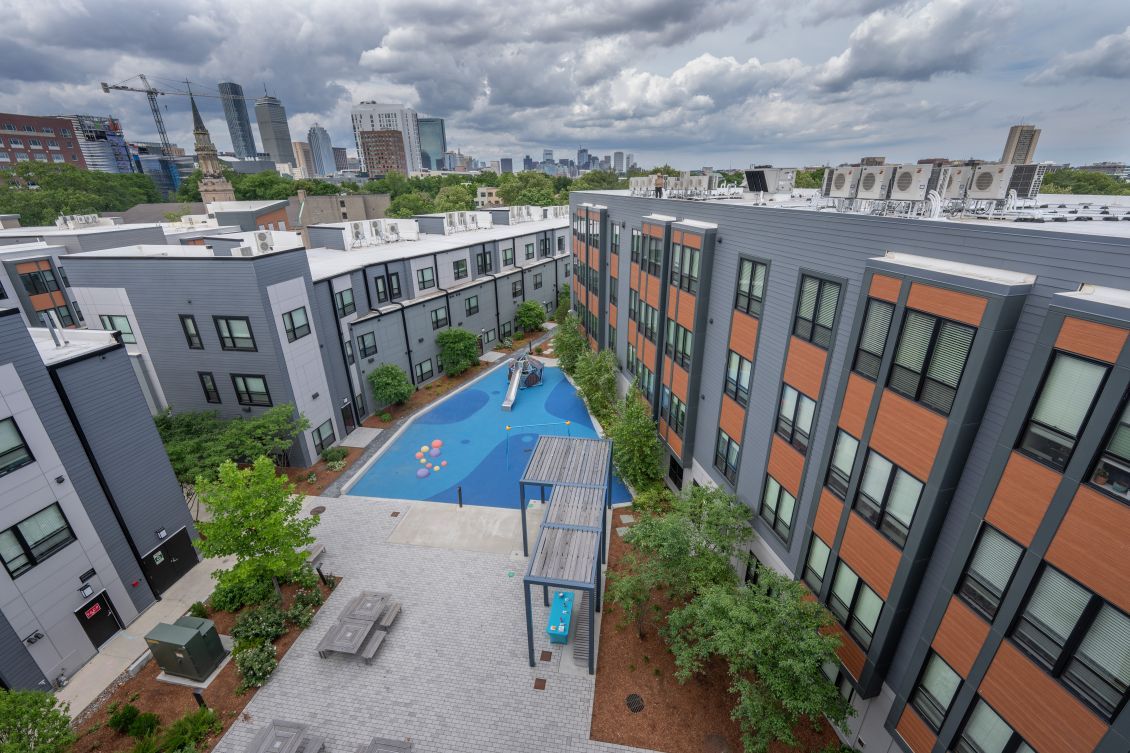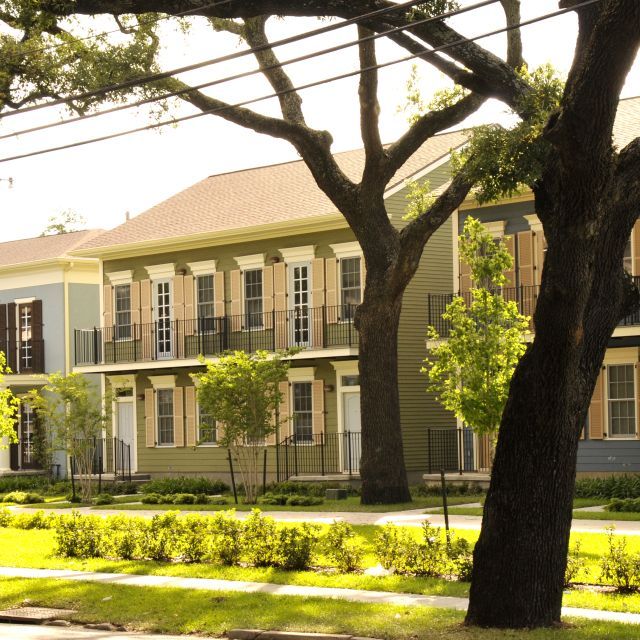Since the August passage of the Inflation Reduction Act, affordable housing advocates including Enterprise Community Partners have dug into the law to find which parts could most benefit affordable multifamily housing.
The law, which marks one of the most substantive climate actions in U.S. legislative history, provides $369 billion for investments in climate resilience, energy security programs and efficiency improvements. As the federal government begins planning to implement these investments, we have a unique opportunity to advance long-held priorities, including the creation and preservation of equitable and sustainable affordable housing. [Read our most recent updates on the IRA here].
On October 13, Enterprise hosted a webinar (see slides) featuring staff experts on policy and climate resilience, as well as remarks from Michael Novogradac, managing partner of Novogradac & Company and a leading expert on the financing and structuring of tax credits for affordable housing. Below are highlights of the four provisions from this groundbreaking law that will benefit affordable multifamily housing:
1. $1 billion for a HUD-led program to improve climate resilience, energy and water efficiency
The Inflation Reduction Act directs $1 billion to grants and loans for improving energy and water efficiency and climate resilience in HUD-assisted multifamily housing. These investments will provide utility bill relief and ensure climate disaster preparedness in our most vulnerable low-income communities. The Green and Resilient Retrofit Program will be administered through HUD’s Office of Housing as part of its Climate Action Plan. The most significant investment from the Inflation Reduction Act with HUD, this program — known as GRRP — will combine direct loan subsidies and competitive grants, paired with technical assistance, to support energy efficiency and climate resilient improvements in assisted multifamily properties.
Properties participating in HUD’s multifamily assisted housing programs, including Section 8, Section 202 and Section 811, will be eligible for these facility retrofits. Multiple rounds of grant and loan funding are anticipated to deploy the $1 billion; all funds must be distributed by September 2028.
HUD has published a Request for Information (RFI) and is seeking public input on the GRRP program. Comments are due October 27.
2. $9 billion in Department of Energy consumer home energy rebate programs for energy efficiency and electrification retrofits, focused on low-income consumers
The law invests in new programs that provide $9 billion in rebates to households for high-efficiency electric appliances and for whole-home energy retrofits. Almost half, $4.3 billion, will be available through the High-Efficiency Home Electric Home Rebate program, which will enable roughly 1 million low- and moderate-income (LMI) households to go electric, according to Rewiring America. The funding will come in the form of point-of-sale rebates for electrification upgrades, up to $14,000 per household. The Qualified Electric Projects include heat pump HVAC systems and water heaters, electric cooking appliances, heat pump clothes dryers, and upgraded circuit panels, insulation, and wiring.
Some $4.5 billion is allocated for efficiency and electrification rebates under the Home Energy Performance-Based, Whole-House Rebates program, which supports energy savings retrofits. These rebates will help multifamily building owners receive up to $8,000 per unit for qualifying energy efficiency retrofits. LMI multifamily buildings will qualify for higher incentive levels.
State Energy Offices will manage both DOE programs, with funding to be distributed by 2031.
3. $41.5 billion from the Environmental Protection Agency for tools to address climate change and advance environmental and climate justice
This portion of the law includes $27 billion in financial assistance for activities or technologies that reduce or avoid greenhouse gas emissions or help communities do so — and prioritizes projects without other access to financing. Of this amount, $15 billion will serve low-income and disadvantaged communities, $7 billion of that to enable communities to deploy or benefit from zero-emission technologies.
There are many discussions on how this funding will be deployed — including via a national green bank. As a national Community Development Financial Institution, Enterprise is focused on how this funding can help seed the nation’s network of CDFIs to coordinate with other community development efforts and advance these program goals. The EPA will start releasing funds in February 2023 and they must be distributed by August 2024.
4. New and expanded tax credits to increase energy efficiency and renewable energy projects
Among the several tax credits that target housing, three clean electricity tax credits intertwine with the Low-Income Housing Tax Credit (Housing Credit): the Section 48 Renewable Energy Investment Tax Credit (ITC); the Section 45L New Energy Efficient Home Credit; and the Section 179D, Commercial Buildings Energy-Efficient Tax Deduction. Since the Housing Credit is the nation’s most successful tool for producing and preserving affordable rental housing, the guidance expected from the Treasury is a top priority to ensure the credits can be used efficiently with the program to make housing more energy efficient and resilient. Most notably, the law eliminates the basis reduction for pairing the Section 48 and 45L credits with the Housing Credit, which was a provision we have advocated for through the Affordable Housing Credit Improvement Act, legislation that is a top priority for Enterprise.
Additionally, Treasury recently released six notices seeking public input on key climate and clean energy tax incentives included in the IRA. Comments are due by November 4, 2022, and subsequent guidance is expected to be released by February 2023.
Here are important details on key sections of the legislation:
-
Section 48: The bill provides a 10-year extension for the ITC, including the Production Tax Credit for solar energy, retroactively from January 1, 2022, and increases the credit from 26 percent to 30 percent. It includes requirements for prevailing wages and apprenticeships and also creates bonuses or add-on credits. The layering of these add-ons can include a 20 percent credit for multifamily developments financed by the Housing Credit and other federal housing programs or a 10 percent bonus if the development is in a low-income community, as defined by the New Markets Tax Credit Program. There is an annual cap for these two add-ons of 1.8 gigawatts for 2023 and 2024, which will be determined in further guidance on allocation from the Treasury. In addition, there is also a 10 percent bonus for using domestic materials on an ITC project.
-
Section 45L: The New Energy Efficient Home credit, or 45L, has received a substantial boost. While existing rules will be used for properties placed in service this year to provide up to $2,000 to developers to build homes that qualify for the DOE’s Zero Energy Ready Homes standard, starting in 2023 the amount can range from $500 to up to $5,000. This applies to new single family, multifamily and manufactured homes, as well as existing homes that undergo a deep retrofit. This aligns well with Enterprise’s Green Communities Certification Plus program.
-
Section 179D: The Commercial Buildings Energy Efficient credit, or 179D, increases the deduction for properties that achieve higher levels of efficiency offering $2.50 to $5.00 per square foot for businesses achieving 25 to 50 percent reductions in energy use over existing building performance standards.
As federal agencies work on draft rules and regulations to implement the historic funding provided under the Inflation Reduction Act, Enterprise is working to provide feedback through the RFI and public comment processes, as well as through direct conversations with the agencies. We encourage our partners working to expand and improve affordable housing across the country to weigh in with recommendations on how to best ensure these dollars flow effectively and efficiently.
We look forward to working with all of you to ensure that the programs laid out here help make homes and communities more sustainable, more affordable, and climate resilient for the future. For more details on the provisions outlined, view the recording and the related slides from the Enterprise. Read our most recent updates on the IRA here.


